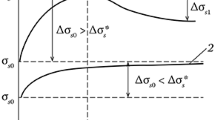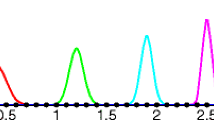Abstract
In this work, we develop a position-based finite element formulation for elasto-plastic solids under contact situation. The proposed positional formulation employs a total Lagrangian description and naturally considers geometric nonlinearities. The employed elasto-plastic model is derived from the dissipation inequality, using the thermodynamic conjugacy between the plastic strain rate and the so-called Mandel stress. The formulation is based on the Kröner–Lee decomposition, in which the deformation gradient is multiplicatively split into its elastic and plastic parts. We apply the backward Euler method to solve the plastic evolutions and von Mises yield criterion to define the elastic limit. The adopted kinematic hardening model is a finite strain generalization of the Armstrong–Frederick law, which uses the objective Jaumann derivative for the evolution equation and the concept of back stress tensor as an internal variable. For the elastic parcel of strains, we adopt a neo-Hookean constitutive law. With respect to the 2D application, plane strain and plane stress approximations are considered, where the latter is solved numerically by a local Newton–Raphson numerical procedure. Regarding the contact problem, a classical node-to-segment algorithm is applied, considering both frictionless and frictional cases, with the introduction of Lagrange multipliers in order to enforce contact constraints. Representative numerical examples are used to validate and show the possibilities of the proposed formulation in macroscale simulation of metal cold forming manufacturing processes.























Similar content being viewed by others
References
Armero F (2006) Energy-dissipative momentum-conserving time-stepping algorithms for finite strain multiplicative plasticity. Comput Methods Appl Mech Eng 195(37):4862–4889 John H. Argyris Memorial Issue. Part I
Armstrong PJ, Frederick C (1966) A mathematical representation of the multiaxial Bauschinger effect. vol 731. Central Electricity Generating Board [and] Berkeley Nuclear Laboratories, Research & Development Department Berkeley
Ayachit U (2015) The ParaView guide: a parallel visualization application. Kitware Inc, Chapel Hill
Bathe KJ, Chaudhary A (1985) A solution method for planar and axisymmetric contact problems. Int J Numer Methods Eng 21(1):65–88
Bonet J, Wood R, Mahaney J, Heywood P (2000) Finite element analysis of air supported membrane structures. Comput Methods Appl Mech Eng 190(5):579–595
Bonet J, Wood RD (2008) Nonlinear continuum mechanics for finite element analysis, 2nd edn. Cambridge University Press, Cambridge
Chaboche J (1986) Time-independent constitutive theories for cyclic plasticity. Int J Plast 2(2):149–188
Coda H, Greco M (2004) A simple FEM formulation for large deflection 2D frame analysis based on position description. Comput Methods Appl Mech Eng 193(33):3541–3557
Coda HB (2009) A solid-like FEM for geometrically non-linear 3D frames. Comput Methods Appl Mech Eng 198(47):3712–3722
Coda HB, Paccola RR (2010) Improved finite element for 3D laminate frame analysis including warping for any cross-section. Appl Math Model 34(4):1107–1137
Coda HB, Paccola RR (2014) A total-lagrangian position-based FEM applied to physical and geometrical nonlinear dynamics of plane frames including semi-rigid connections and progressive collapse. Finite Elem Anal Des 91:1–15
Dagum L, Menon R (1998) OpenMP: an industry-standard API for shared-memory programming. IEEE Comput Sci Eng 5(1):46–55
De Coninck A, De Baets B, Kourounis D, Verbosio F, Schenk O, Maenhout S, Fostier J (2016) Needles: toward large-scale genomic prediction with marker-by-environment interaction. Genetics 203(1):543–555. https://doi.org/10.1534/genetics.115.179887
Dettmer W, Reese S (2004) On the theoretical and numerical modelling of Armstrong–Frederick kinematic hardening in the finite strain regime. Comput Methods Appl Mech Eng 193(1):87–116
Dogui A, Sidoroff F (1985) Kinematic hardening in large elastoplastic strain. Eng Fract Mech 21(4):685–695
Eterovic AL, Bathe KJ (1991) A note on the use of the additive decomposition of the strain tensor in finite deformation inelasticity. Comput Methods Appl Mech Eng 93(1):31–38
Feng ZQ, Peyraut F, Labed N (2003) Solution of large deformation contact problems with friction between Blatz–Ko hyperelastic bodies. Int J Eng Sci 41(19):2213–2225
Geuzaine C, Remacle JF (2009) Gmsh: a three-dimensional finite element mesh generator with built-in pre- and post-processing facilities. Int J Numer Methods Eng 79:1309–1331
Hallquist J (1979) NIKE2D: an implicit, finite-deformation, finite-element code for analyzing the static and dynamic response of two-dimensional solids
Hallquist J, Goudreau G, Benson D (1985) Sliding interfaces with contact-impact in large-scale lagrangian computations. Comput Methods Appl Mech Eng 51(1):107–137
Haupt P (1985) On the concept of an intermediate configuration and its application to a representation of viscoelastic-plastic material behavior. Int J Plast 1(4):303–316
HSL: a collection of Fortran codes for large scale scientific computation. http://www.hsl.rl.ac.uk/
Hughes TJ, Taylor RL, Sackman JL, Curnier A, Kanoknukulchai W (1976) A finite element method for a class of contact-impact problems. Comput Methods Appl Mech Eng 8(3):249–276
Khan A, Huang S (1995) Continuum theory of plasticity. Wiley, Hoboken
Kourounis D, Fuchs A, Schenk O (2018) Towards the next generation of multiperiod optimal power flow solvers. IEEE Trans Power Syst PP(99):1–10. https://doi.org/10.1109/TPWRS.2017.2789187
Kröner E (1960) Allgemeine kontinuumstheorie der versetzungen und eigenspannungen. Arch Ration Mech Anal 4(4):273–334
Lee EH (1969) Elastic–plastic deformation at finite strains. J Appl Mech 36(1):1–6
Lührs G, Hartmann S, Haupt P (1997) On the numerical treatment of finite deformations in elastoviscoplasticity. Comput Methods Appl Mech Eng 144(1):1–21
Mandel J (1973) Thermodynamics and plasticity. Macmillan Education, London, pp 283–304
Mollica F, Rajagopal K, Srinivasa A (2001) The inelastic behavior of metals subject to loading reversal. Int J Plast 17(8):1119–1146
Oliveira M, Alves J, Chaparro B, Menezes L (2007) Study on the influence of work-hardening modeling in springback prediction. Int J Plast 23(3):516–543
Papadopoulos P, Taylor RL (1992) A mixed formulation for the finite element solution of contact problems. Comput Methods Appl Mech Eng 94(3):373–389
Pascon J, Coda H (2013) Large deformation analysis of elastoplastic homogeneous materials via high order tetrahedral finite elements. Finite Elem Anal Des 76:21–38
Simo J, Hughes T (2006) Computational inelasticity. Interdisciplinary applied mathematics. Springer, New York
Simo JC, Wriggers P, Taylor RL (1985) A perturbed lagrangian formulation for the finite element solution of contact problems. Comput Methods Appl Mech Eng 50(2):163–180
Svendsen B (1998) A thermodynamic formulation of finite-deformation elastoplasticity with hardening based on the concept of material isomorphism. Int J Plast 14(6):473–488
Svendsen B, Arndt S, Klingbeil D, Sievert R (1998) Hyperelastic models for elastoplasticity with non-linear isotropic and kinematic hardening at large deformation. Int J Solids Struct 35(25):3363–3389
Tsakmakis C, Willuweit A (2003) Use of the elastic predictor-plastic corrector method for integrating finite deformation plasticity laws. Springer, Berlin, pp 79–106
Tur M, Fuenmayor F, Wriggers P (2009) A mortar-based frictional contact formulation for large deformations using lagrange multipliers. Comput Methods Appl Mech Eng 198(37–40):2860–2873
Verbosio F, Coninck AD, Kourounis D, Schenk O (2017) Enhancing the scalability of selected inversion factorization algorithms in genomic prediction. J Comput Sci 22(Supplement C):99–108. https://doi.org/10.1016/j.jocs.2017.08.013
Vladimirov IN, Pietryga MP, Reese S (2008) On the modelling of non-linear kinematic hardening at finite strains with application to springback—comparison of time integration algorithms. Int J Numer Methods Eng 75(1):1–28
Williams T, Kelley C et al (2013) Gnuplot 4.6: an interactive plotting program. http://gnuplot.sourceforge.net/
Wriggers P (2006) Computational contact mechanics. Springer, Berlin
Wriggers P, Van TV, Stein E (1990) Finite element formulation of large deformation impact-contact problems with friction. Comput Struct 37(3):319–331
Yang B, Laursen TA, Meng X (2005) Two dimensional mortar contact methods for large deformation frictional sliding. Int J Numer Methods Eng 62(9):1183–1225
Zavarise G, Lorenzis LD (2009) The node-to-segment algorithm for 2D frictionless contact: classical formulation and special cases. Comput Methods Appl Mech Eng 198(41):3428–3451
Zienkiewicz O, Taylor R, Fox D (2014) The finite element method for solid and structural mechanics, vol 2. Butterworth-Heinemann, Oxford
Acknowledgements
The authors would like to acknowledge the Brazilian agency National Council for Scientific and Technological Development (CNPq), the Coordenação de Aperfeiçoamento de Pessoal de Nível Superior (CAPES) and the São Paulo Research Foundation (FAPESP) for the financial support given to this research.
Funding
This study was financed in part by the Coordenação de Aperfeiçoamento de Pessoal de Nível Superior - Brasil (CAPES)—finance code 001, by Brazilian National Council for Research and Technological Development (CNPq)—Grants 310482/2016-0 and by São Paulo Research Foundation (FAPESP)—Process Number 2018/23957-2.
Author information
Authors and Affiliations
Corresponding author
Ethics declarations
Conflict of interest
The authors declare that they have no conflict of interest.
Additional information
Technical Editor: João Marciano Laredo dos Reis.
Publisher's Note
Springer Nature remains neutral with regard to jurisdictional claims in published maps and institutional affiliations.
Rights and permissions
About this article
Cite this article
Carvalho, P.R.P., Coda, H.B. & Sanches, R.A.K. Positional finite element formulation for two-dimensional analysis of elasto-plastic solids with contact applied to cold forming processes simulation. J Braz. Soc. Mech. Sci. Eng. 42, 245 (2020). https://doi.org/10.1007/s40430-020-02344-z
Received:
Accepted:
Published:
DOI: https://doi.org/10.1007/s40430-020-02344-z




